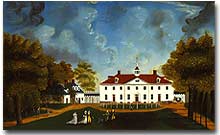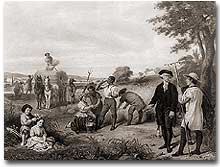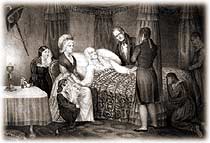17e. Mount Vernon and the Dilemma of a Revolutionary Slave Holder

This painting, from the late 1700s, is an idyllic portrait of George Washington's Mount Vernon estate.
George Washington, like most powerful Virginians of the 18th century, derived most of his wealth and status from the labor of African and African American slaves. At his father's death in 1743, eleven-year-old George inherited ten slaves. His property grew larger with the death of his half-brother Lawrence in 1754, which brought him the 2600 -acre plantation of Mt. Vernon along with another 18 slaves.
Greater still, was the wealth that Martha Custis brought to the marriage. While most of her slaves remained on other properties, she brought 12 personal slaves with her when she moved to Mt. Vernon in 1759. Washington was energetic and purposeful in all aspects of life, which included being a successful plantation master. By 1786 his careful management had increased his property to 7300 acres and 216 slaves.
Washington's ability as a planter placed him within the traditional gentry elite of Virginia. His wealth rested on the exploitation of humans as property, but he expressed no qualms about benefiting from what we now see as a fundamentally immoral institution. However, the American Revolution challenged Washington's traditional acceptance of slavery on both pragmatic and idealistic grounds. When Washington arrived in Massachusetts in 1775 to take command of the patriot militia that was surrounding the British in Boston, he was surprised to discover that New Englanders had begun to allow free African Americans as well as slaves to join their ranks as soldiers.
After meeting with his officers, Washington reversed this policy and tried to make an all-white Continental Army. The following month the British Army in Virginia declared that any slave of a patriot master who fled to fight the patriots would gain his freedom. This policy may have been referenced by Francis Scott Key in the poem that was to become our national anthem, with the line "No refuge could save the hireling and slave / From the terror of flight, or the gloom of the grave: " This line, and indeed, all but the first stanza, is most often ommitted from modern performances of the anthem.
Washington immediately grasped the strategic crisis posed by this British promise of freedom in a country where one in every five people was black. In fact, seventeen Mt. Vernon slaves fled to join the British during the war. Pragmatic concerns quickly led Washington to reverse his policy and by December 1775 the Continental Army, in the North at least, included black soldiers.

An idyllic painting of what life was like on Washington's plantation, Mount Vernon.
Washington's Revolutionary ideals also helped transform his attitude toward slavery. When contemplating the British actions that compelled him to join the patriot cause, Washington explained to his old friend George Fairfax that British "custom and use shall make us as tame and abject slaves as the blacks we rule over with such arbitrary sway."
Like many other patriots of the period, Washington described British tyranny as threatening to enslave white Americans. Slavery was the condition that everyone knew to be the most extreme example of human oppression. While the invocation of the slavery metaphor was widespread, Washington went a major step further than most of his fellow slave masters. He decided to limit the severity of his plantation discipline and, ultimately, he even freed his slaves.
Washington's emancipation of his slaves was an unusual and honorable decision for a man of his day. No other Virginia Founding Father matched his bold steps. By the early 1770s Washington clearly tried to lessen the evils of slavery on his plantation. From this point on he rarely bought a slave and never sold them away from Mt. Vernon without their consent. Washington hoped to act as a humane master by keeping slave families together. However, he soon discovered that slavery was only profitable when operated in a brutal fashion. Mt. Vernon became increasingly inefficient in Washington's final two decades.

Death of Washington captures the first president on his death bed with Martha Washington by his side.
Five months before his death, Washington drew up a will that included a detailed and exact description of how his slaves were to be freed. Beyond freedom, those slaves who were children were to receive occupational training and to learn to read and write, while elderly slaves were to receive financial support. Knowing full well that some heirs would dislike this loss of their potential inheritance, Washington insisted that "this clause respecting Slaves, and every part thereof be religiously fulfilled ... without evasion, neglect, or delay."
In spite of these far reaching actions, some may still judge Washington's post-Revolutionary attitude toward slavery too limited. At his death in 1799, Mt. Vernon included 317 slaves, but only 124 of them belonged to George and only these would be freed. The rest were Martha's. Temporarily inherited from her deceased first husband, they would pass to her heirs upon her death and could not be legally controlled by George. More significantly, however, Washington never publicly explained his new belief that slavery should end.
In a private letter in 1786 he stated, it is "among my first wishes to see some plan adopted, by the legislature by which slavery in this Country may be abolished by slow, sure, and imperceptible degrees." Even his private commitment was to a cautious and gradual process, but he never allowed even this moderate anti-slavery position to be known publicly. In the end, Washington's commitment to national unity prevented him from throwing his enormous public stature behind the radical cause of emancipation. He feared that such action would deeply divide the new nation.
Could Washington have forged an anti-slavery coalition that might have ended the evil institution and avoided the bloodshed of the Civil War? Might public action on his part have caused an earlier civil war that would have wrecked the nation still in its infancy? Those are questions that History cannot answer and that we can never know. But it is clear that in his own cautious way Washington struggled with the most profound question of the Revolutionary Era and ultimately decided that his moral sense of what was right overcame his personal interest in perpetuating slavery.






